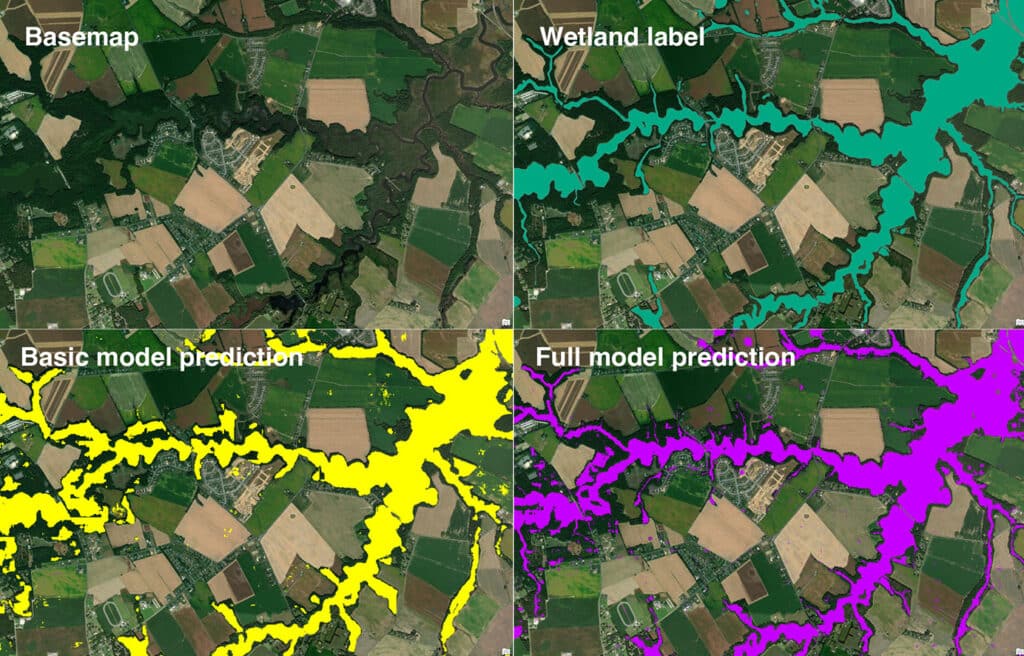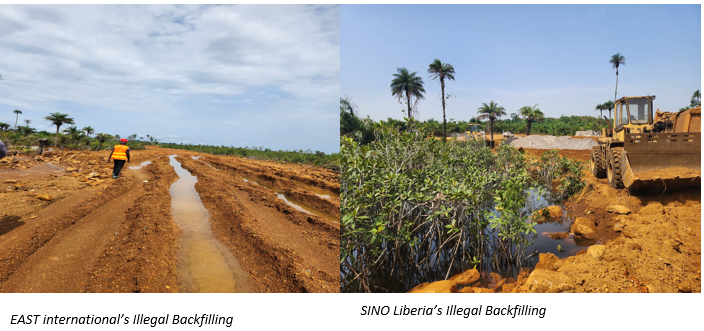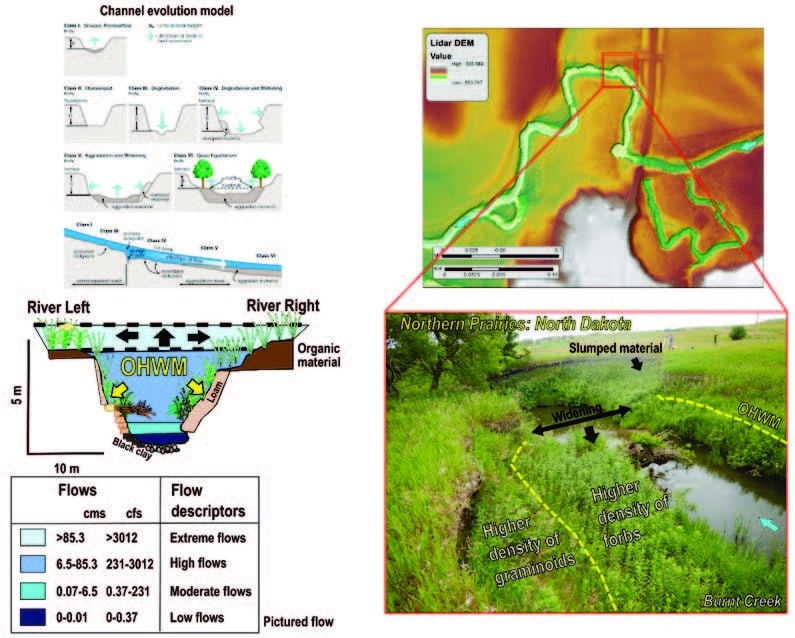The use of a survey grade level is critical for obtaining accurate measurements of various biological features, biological benchmarks, etc. This information is used for many purposes including stream restoration, coastal restoration, wetland restoration, and other design purposes.
There are two types of levels used for construction and design. The older of the two is known as the Dumpy level. This level is like a spotting scope with crosshairs. It is highly accurate (despite its name) and has an added advantage of being able to measure distance. However, it does require much more work to operate and is limited to a range of about 30 feet. It also requires two people to operate.
Laser levels are the other commonly used measuring tool and are a significant improvement over the Dumby levels. The major benefit is that the distance away from the level is pretty much as far as you can see. This reduces the number of station moves and speeds the process along. You also only need to have one person to operate the level.
There is a third option which is to use a surveyor total station. This, however, is a complicated process and usually beyond the level of detail needed for most biological assessments. A corollary to this is the use of GPS. GPS is great for x and y coordinates, but it is often meters off on the elevation (z).
Laser Levels
You do not need to spend a lot of money to purchase a quality laser level. You can often find these for sale in big box home improvements stores and hardware stores. They are around a couple of hundred dollars. You can also rent one from a survey supply shop for about $20-$30 per day. Survey grade levels are usually in the $500 to $1000 range. This is worth the investment if this type of work is a regular thing for you. Also, do not cheap out on the box. The level will get bounced around so you will need a quality instrument case. This is sometimes a problem with the home center levels.
The laser receiver is usually included with the laser level. This is a little box that attaches to the survey rod with thumb screws. It takes batteries and makes a tone when the laser beam from the level hits it.
The level should be placed upon a quality tripod. This is not the same type as you use for a camera. Survey grade tripods are usually made of wood or aluminum and have steel spikes to set it into the ground. The legs are adjustable so that you can adjust your level. The level should be about chest high when mounted so the tripod needs to be 4-5 feet high when set up.
Next on your shopping list is a survey rod. You want to get the smallest rod that will serve the purposes of the site work you are doing. A 12-foot rod is much better than a 25-foot rod if you only need to go up a few feet. The bigger the rod the more sway you have, and the measurements will be less accurate. However, if you have a steep slope on your site, a bigger rod may be necessary.
You will also need a measuring tape or carpenter’s rule. It is better to get one that is calibrated to 1/10’s of a foot rather than inches. The survey rod is always in 1/10’s of a foot, however, make sure you are not using a metric rod.
Set Up
The first thing that you want to do is take a walk around the area that you need to survey. You want to find the best place to set up the level so that you do not need to move it more than necessary. Keep an eye on slope, trees and other obstructions. The level needs a clear line of sight. You can clear some of the vegetation away, but it is usually easier to find a spot that would require the least amount of work to get your shots. The tripod should be set up above the highest point you are going to survey. You need to include the height of the level receiver on the rod when you are making this estimate. This translates to about 5 feet above your highest point. The level needs to be able to “see” the receiver. If the level is set is too low it will shoot below the receiver mounted on the rod. You can move the receiver down, but that would require that you recalculate for those shots.
Keep the level in the box until you are ready to place it on the tripod. Do not attach it to the tripod and then walk around with it. It should be boxed when moving it around the site.
Set the legs up on as level a surface as you can. Adjust the legs so that the level mounting plate is fairly level. You can use a hand level to do this or the bubble level on the laser level itself.
The laser level attaches to the tripod by way of a large screw below the mounting plate. Do not tighten this too much until you have leveled the level. There are three or four leveling screws on the level. There is also a glass bubble level on the mounting plate. Adjust the leveling screws so that the level is dead on the level in all directions. This will require that you spin the level around and make adjustments. If you have attempted to level the tripod before you mounted the level, this will go fairly quickly.
Instrument Height
There is usually a marking on the level where you should measure downwards to the ground. We are also going to determine the height of the instrument using the back site, but you should always measure the distance from the instrument to the ground.
Backsight
You should place a project benchmark somewhere near the level set up. This serves as your project control and can be surveyed for real later if you need to derive actual elevation points from your level runs. This control should be set using a pin, rod, pipe or other relatively permanent makers. Wooden stakes do not work as they can be easily removed or damaged.
The backsight elevation is any number that makes sense. The convention is to set it at 100. You may come back later in drag control onto the site to determine the actual elevation, but that is not necessary for this type of work.
The laser level indicator should be attached to the rod, usually at the tip. Note the location of the indicator. For example, it is on the rod at 4.5 feet. Most telescopic rods have a height indicator on the back of the rod. As you raise the rod the height indicator numbers will change. Be careful to raise the rod in the proper order. This varies with some rod types so be sure to check with the manufacturer on the use of the rod.
A Direct Elevation Rod or a “ Lenker Rod ” is the most common type and has numbers in reverse order on a graduated strip that revolves around the rod on rollers. Figures run down the rod and can be brought to the desired reading—for example, the elevation of a point or benchmark. Rod readings are preset for the backsight, and then, due to the reverse order of numbers, foresight readings give elevations directly without calculating backsights and foresights.
Turn the laser on and position the rod on the benchmark and raise the rod until you hear a steady tone. You will usually hear a slow chip when you are just below the laser beam and a fast chirp when you go past it. Note the rod reading. That is your backsight reading. Add the elevation from the benchmark rod reading and you have your height of instrument (HI).
For example, your benchmark is elevation one hundred. Your rod reading on that benchmark is 4.06. Therefore, your Height of Instrument (HI) is 104.06’. Your benchmark elevation should be lower than the instrument ground location. If not, you need to adjust the detector and do some more math. It can be done, but it takes more time.
Now you are ready to go to work on the foresight.
Position the rod directly on the ground at each feature shot. The rod should be straight up and down. There are plumb levels you can attach to the rod to help you. Some laser detectors will also beep at you if you are too far out of plumb.
Raise the rod until you hear that steady tone. Note the rod reading. Make sure that you raised the rod in the right order and that the numbers are being read correctly. Usually, this is a matter of checking reality. If your rod reading suddenly jumps by 5 feet from the last point you may have raised the rod sections in the wrong order.
Record each feature and provide some notes. A level book works great for this. This is an example of a level book set up.
Set Up-Example 1
At each feature subtract the foresight (FS) from the Height of Instrument (HI) to derive the elevation.
In this example, we have a 1.28’ difference from mid tide (MT) to Mean High Water (MHW). We can, therefore, assume that our total tidal exchange would be 2.56’ from Mean Low Water (MLW) to MHW.
We would need to check many other points. Usually, for a biological benchmark survey, we would to stationing along a cross-section. Each feature would be relative to the feature type and its location on the cross-section. In our example above, the distance from the MT to MHW is 25’. This is measured by setting a fixed starting point at 0+00 and measuring along that line.
If you need to move the level you will need to calculate a new HI. Make sure to reference the setup with the data. Start a new table for a new set up.
Finally, if you need to determine the real elevations of your features survey the benchmark. This will require a surveyor to locate nearby elevation control and drag that onto the site using traverse lines. You can also use high-end GPS for this. In our example above the real elevation for the benchmark is 456’ NAVD 88. Our new HI is 460.06. We need to make sure we cite the vertical data source. In this case, it is North American Vertical Datum of 1988 (NAVD 88). Therefore, our MT is 453.43’ NAVD 88 and the MHW is 454.71’ NAVD 88. You can do this for all the data associated with the benchmark.
One final note
If you are doing level runs for design purposes, you may or may not need a licensed land surveyor to sign off on them. However, if you are doing any floodplain calculation work you will most likely need the help of a licensed surveyor. Some jurisdictions allow licensed professional engineers to do this as well. This is a matter of state and federal law so be careful and ask questions.





